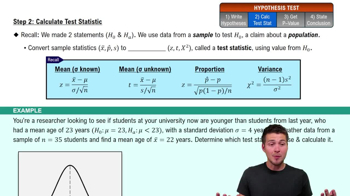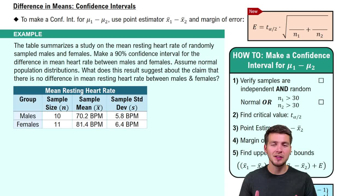Cola Weights The displayed results from Exercise 1 are from one-way analysis of variance. What is it about this test that characterizes it as one-way analysis of variance instead of two-way analysis of variance?
Table of contents
- 1. Intro to Stats and Collecting Data1h 14m
- 2. Describing Data with Tables and Graphs1h 55m
- 3. Describing Data Numerically2h 5m
- 4. Probability2h 16m
- 5. Binomial Distribution & Discrete Random Variables3h 6m
- 6. Normal Distribution and Continuous Random Variables2h 11m
- 7. Sampling Distributions & Confidence Intervals: Mean3h 23m
- Sampling Distribution of the Sample Mean and Central Limit Theorem19m
- Distribution of Sample Mean - Excel23m
- Introduction to Confidence Intervals15m
- Confidence Intervals for Population Mean1h 18m
- Determining the Minimum Sample Size Required12m
- Finding Probabilities and T Critical Values - Excel28m
- Confidence Intervals for Population Means - Excel25m
- 8. Sampling Distributions & Confidence Intervals: Proportion1h 12m
- 9. Hypothesis Testing for One Sample3h 29m
- 10. Hypothesis Testing for Two Samples4h 50m
- Two Proportions1h 13m
- Two Proportions Hypothesis Test - Excel28m
- Two Means - Unknown, Unequal Variance1h 3m
- Two Means - Unknown Variances Hypothesis Test - Excel12m
- Two Means - Unknown, Equal Variance15m
- Two Means - Unknown, Equal Variances Hypothesis Test - Excel9m
- Two Means - Known Variance12m
- Two Means - Sigma Known Hypothesis Test - Excel21m
- Two Means - Matched Pairs (Dependent Samples)42m
- Matched Pairs Hypothesis Test - Excel12m
- 11. Correlation1h 6m
- 12. Regression1h 50m
- 13. Chi-Square Tests & Goodness of Fit1h 57m
- 14. ANOVA1h 57m
9. Hypothesis Testing for One Sample
Steps in Hypothesis Testing
Problem 13.3.2a
Textbook Question
Hospital Admissions For the matched pairs listed in Exercise 1, identify the following components used in the Wilcoxon signed-ranks test:
a. Differences d
 Verified step by step guidance
Verified step by step guidance1
Step 1: Understand the Wilcoxon signed-ranks test. This test is a non-parametric statistical test used to compare two related samples, matched pairs, or repeated measurements on a single sample to assess whether their population mean ranks differ. It is often used as an alternative to the paired t-test when the data does not meet the assumptions of normality.
Step 2: Identify the matched pairs from the problem. These pairs represent the two related samples or measurements that are being compared. For example, they could be 'before' and 'after' measurements for the same subjects.
Step 3: Calculate the differences (d) for each pair. For each matched pair, subtract one value from the other. The difference is typically calculated as d = x1 - x2, where x1 and x2 are the two values in the pair.
Step 4: Record the differences (d) for all pairs. Ensure that you keep track of the sign of each difference (positive or negative), as this will be important for the next steps in the Wilcoxon signed-ranks test.
Step 5: Verify the differences. Check that all differences have been calculated correctly and that no data points are missing. This step ensures the accuracy of the subsequent analysis.
 Verified video answer for a similar problem:
Verified video answer for a similar problem:This video solution was recommended by our tutors as helpful for the problem above
Video duration:
2mPlay a video:
Was this helpful?
Key Concepts
Here are the essential concepts you must grasp in order to answer the question correctly.
Wilcoxon Signed-Ranks Test
The Wilcoxon signed-ranks test is a non-parametric statistical method used to compare two related samples or matched pairs. It assesses whether their population mean ranks differ, making it suitable for data that do not meet the assumptions of normality required for parametric tests. This test is particularly useful in situations where the sample size is small or when the data are ordinal.
Recommended video:
Guided course

Step 2: Calculate Test Statistic
Differences (d)
In the context of the Wilcoxon signed-ranks test, 'differences (d)' refer to the calculated differences between paired observations. For each pair, the difference is computed by subtracting one value from the other. These differences are then ranked, and the test evaluates the sum of the ranks of the positive and negative differences to determine if there is a statistically significant difference between the two related groups.
Recommended video:
Guided course

Difference in Means: Confidence Intervals
Ranked Data
Ranked data is a method of organizing data points based on their order rather than their actual values. In the Wilcoxon signed-ranks test, the absolute values of the differences are ranked from smallest to largest, regardless of their sign. This ranking process allows the test to analyze the relative positions of the differences, which is essential for determining the significance of the results without relying on the assumptions of normal distribution.
Recommended video:
Guided course

Visualizing Qualitative vs. Quantitative Data

 6:21m
6:21mWatch next
Master Step 1: Write Hypotheses with a bite sized video explanation from Patrick
Start learningRelated Videos
Related Practice
Textbook Question
